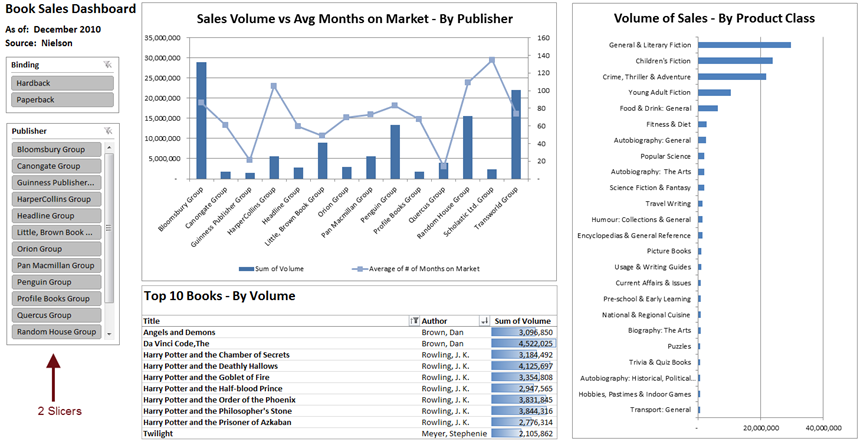Overview: This blog entry discusses using slicers within Excel 2010 to filter the data being presented, with an emphasis on choosing between traditional filters & slicers.
Level: Basic understanding of an Excel PivotTable is helpful.
Slicing and Dicing a Set of Data
The phrase “slice and dice” is used a lot when referring to the analysis of data. The Slicing part refers to filtering your data to focus on just a subset – essentially the “where” statement. Dicing the data refers to selecting which attributes we’re grouping the data by. For instance, if we have a PivotTable showing Internet Sales for 2006 and 2007 by Country and by State, then we have sliced the data by year and diced it by geography.
What is a Slicer in Excel 2010?
Excel 2010 introduces slicers as an alternative to traditional PivotTable filters (i.e., the Report Filter and the Row/Column Filters).
Following is an example of how slicers are presented in Excel:
The above screen shot uses publicly available data I originally downloaded from the UK Guardian Data Store.
If you’re not familiar with slicers, take a quick look at the following before reading on:
Connecting Slicers to One or More PivotTables
Connecting a slicer to more than one Table is the greatest benefit of slicers & what makes them better than traditional PivotTable filters (i.e., the Report Filter and the Row/Column Filters). Slicers are extremely useful if you create a dashboard page and you want one click to affect multiple items on the page. There’s a catch though: the multiple PivotTables must use the same underlying data connection.
---> Hint! Using PowerPivot to mashup, or consolidate, your data from different sources can be of real benefit.
If you are displaying (and slicing on) a PivotChart, there must be a PivotTable “underneath” the PivotChart. In the Book Sales Dashboard screen shot shown above, I placed the PivotTables which support the two charts on a hidden worksheet.
Choosing Between Slicers & Traditional PivotTable Filters
Technically, this is not an either/or decision. Slicers can be used in conjunction with standard PivotTable filter functionality (i.e., the Report Filter, Column, and Row Filters).
A Slicer may work better if:
- You want to control filtering of > 1 PivotTable with one click. Since traditional filters are associated with one PivotTable only, slicers really have the potential to make Excel dashboard far more functional.
- You want to display the same field in the slicer as well as on the columns or rows. The ability to slice & dice by the same field is not allowed by the Report Filter.
- Seeing the items currently selected directly on the worksheet is helpful (i.e., the current state of the filter), as opposed to “Multiple Items” in the Report Filter, or just a small icon which can easily be overlooked.
- Flexibility for placement, sizing, or formatting of the slicer is of importance.
- You only have 2-4 different fields to filter on (more than that can just take up so much space).
A traditional Report Filter may be better if:
- Space on the page is at a premium. Whereas slicers take up quite a bit of space, Report Filters show their selections via a compact drop-down menu.
- Your user base is familiar with standard PivotTable functionality.
- You have more than 4 or 5 different fields to filter on.
- The user interaction needs to be a hierarchical tree (ex: Country > State > City). A Report Filter will show these in a tree structure, whereas a slicer will split them up into separate (but related) slicers.
A traditional Row/Column Filter may be the best choice if:
- You need Top 10, Label Filters, or Value Filters which are part of traditional PivotTable filters. (Slicers and Report Filters work filter on attributes only.)
- Space on the page is at a premium. Whereas slicers take up quite a bit of space, Row/Column filters are embedded within the PivotTable itself.
- Your user base is familiar with standard PivotTable functionality.
- You have more than 4 or 5 different fields to filter on.
- The user interaction needs to be a hierarchical tree (ex: Country > State > City). A Row/Column Filter will show these in a tree structure, whereas a slicer will split them up into separate (but related) slicers.
Slicers in the PowerPivot Field List
A PivotTable that is associated to a PowerPivot data source has two additional Slicers panes available that the standard Excel PivotTable doesn’t have.
The “Slicers Vertical” pane in the PowerPivot Field List:
The “Slicers Horizontal” pane in the PowerPivot Field List:
When you add a slicer to the PowerPivot Field List (either the Vertical or Horizontal shown above), Excel automatically creates a rectangle outside of the slicer. If you move the slicer around on the workbook, outside of the rectangle, the slicer will still work – however, it disappears from being shown in either of the slicer panes. Basically it becomes a stand-alone slicer in this situation.
A stand-alone slicer used with a standard PivotTable Field List (i.e., not associated to PowerPivot):
Finding More Information
The Basics:
Excel 2010 Help – Use Slicers to Filter PivotTable Data
Excel Blog - Easy (And Even Fun!) Data Exploration: Introducing Excel 2010 Slicers
Excel Blog – Interacting with Slicers
More Advanced:
MSDN – How to Highlight Table Rows Based on Slicer Selection (a great technique if you’re ready for something a bit more advanced)
Javier Guillen’s Blog – PowerPivot Slicers
Jen Stirrup’s Blog – Excel Slicers and Good Interface Design








